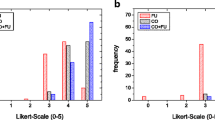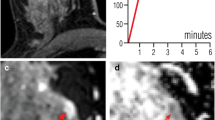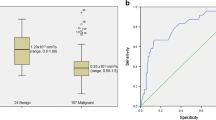Abstract
Diffusion-weighted imaging (DWI) techniques have shown potential to differentiate between benign and malignant neoplasms. However, the diagnostic significance of using DWI under routine conditions remains unclear. This study investigated the use of echo planar imaging (EPI) and half-Fourier acquired single-shot turbo spin echo (HASTE)-DWI with respect to the three parameters: lesion visibility, apparent diffusion coefficient (ADC) measurements, and size estimation. Following MRM (1.5 T), EPI- and HASTE-DWI were applied in 65 patients. Lesion visibility on DWI was compared with lesion visibility on subtracted contrast-enhanced T1w images (CE-T1w). Statistical tests were applied to diameter, visibility, and ADC value measurements. Seventy-four lesions were identified. ADC value measurements did not differ significantly between the two DWI sequences. The sensitivity and specificity of routine diagnostics (97.4% and 85.7%) were superior to EPI-DWI (87.2% and 82.9%) and HASTE-DWI (76.9% and 88.6%). Selecting only nonmass lesions, DWI did not prove to be of diagnostic value. Lesion demarcation by DWI was significantly lower compared with that by CE-T1w, with EPI-DWI showing the better performance (p < 0.001). No significant differences were found for size measurements between CE-T1w and DWI. Although clearly inferior compared with CE-T1w imaging, both DWI techniques are applicable for lesion assessment and size measurements.




Similar content being viewed by others
References
Berg WA, Gutierrez L, NessAiver MS et al (2004) Diagnostic accuracy of mammography, clinical examination, US, and MR imaging in preoperative assessment of breast cancer. Radiology 233:830–849
Echevarria JJ, Martin M, Saiz A et al (2006) Overall breast density in MR mammography: diagnostic and therapeutic implications in breast cancer. J Comput Assist Tomogr 30:140–147
Sardanelli F, Giuseppetti GM, Panizza P et al (2004) Sensitivity of MRI versus mammography for detecting foci of multifocal, multicentric breast cancer in Fatty and dense breasts using the whole-breast pathologic examination as a gold standard. AJR 183:1149–1157
Winnekendonk G, Krug B, Warm M et al (2004) Diagnostic value of preoperative contrast-enhanced MR imaging of the breast. Rofo 176:688–693
Houssami N, Ciatto S, Macaskill P et al (2008) Accuracy and surgical impact of magnetic resonance imaging in breast cancer staging: systematic review and meta-analysis in detection of multifocal and multicentric cancer. J Clin Oncol 26:3248–3258
Kuhl CK (2007) Current status of breast MR imaging. Part 2. Clinical applications. Radiology 244:672–691
Kuhl CK (2007) The current status of breast MR imaging. Part I. Choice of technique, image interpretation, diagnostic accuracy, and transfer to clinical practice. Radiology 244:356–378
Mann RM, Kuhl CK, Kinkel K et al (2008) Breast MRI: guidelines from the European Society of Breast Imaging. Eur radiol 18:1307–1318
Baum F, Fischer U, Vosshenrich R et al (2002) Classification of hypervascularized lesions in CE MR imaging of the breast. Eur radiol 12:1087–1092
Ikeda DM, Hylton NM, Kuhl CK et al (2003) MRI breast imaging reporting and data system atlas, 1 edn. American College of Radiology, Reston
Kuhl CK, Mielcareck P, Klaschik S et al (1999) Dynamic breast MR imaging: are signal intensity time course data useful for differential diagnosis of enhancing lesions? Radiology 211:101–110
Malich A, Fischer DR, Wurdinger S et al (2005) Potential MRI interpretation model: differentiation of benign from malignant breast masses. Ajr 185:964–970
Kaiser WA, Zeitler E (1989) MR imaging of the breast: fast imaging sequences with and without Gd-DTPA. Preliminary observations. Radiology 170:681–686
Guo Y, Cai YQ, Cai ZL et al (2002) Differentiation of clinically benign and malignant breast lesions using diffusion-weighted imaging. J Magn Reson Imaging 16:172–178
Hatakenaka M, Soeda H, Yabuuchi H et al (2008) Apparent diffusion coefficients of breast tumors: clinical application. Magn Reson Med Sci 7:23–29
Kinoshita T, Yashiro N, Ihara N et al (2002) Diffusion-weighted half-Fourier single-shot turbo spin echo imaging in breast tumors: differentiation of invasive ductal carcinoma from fibroadenoma. J Comput Assist Tomogr 26:1042–1046
Luo JD, Liu YY, Zhang XL et al (2007) Application of diffusion weighted magnetic resonance imaging to differential diagnosis of breast diseases. Ai zheng 26:168–171
Matsuoka A, Minato M, Harada M et al (2008) Comparison of 3.0-and 1.5-tesla diffusion-weighted imaging in the visibility of breast cancer. Radiat Med 26:15–20
Roth Y, Ocherashvilli A, Daniels D et al (2008) Quantification of water compartmentation in cell suspensions by diffusion-weighted and T(2)-weighted MRI. Magn Reson Imaging 26:88–102
Rubesova E, Grell AS, De Maertelaer V et al (2006) Quantitative diffusion imaging in breast cancer: a clinical prospective study. J Magn Reson Imaging 24:319–324
Wenkel E, Geppert C, Schulz-Wendtland R et al (2007) Diffusion weighted imaging in breast MRI: comparison of two different pulse sequences. Acad Radiol 14:1077–1083
Woodhams R, Matsunaga K, Iwabuchi K et al (2005) Diffusion-weighted imaging of malignant breast tumors: the usefulness of apparent diffusion coefficient (ADC) value and ADC map for the detection of malignant breast tumors and evaluation of cancer extension. J Comput Assist Tomogr 29:644–649
Woodhams R, Matsunaga K, Kan S et al (2005) ADC mapping of benign and malignant breast tumors. Magn Reson Med Sci 4:35–42
Marini C, Iacconi C, Giannelli M et al (2007) Quantitative diffusion-weighted MR imaging in the differential diagnosis of breast lesion. Eur radiol 17:2646–2655
Kaiser W (1985) MRI of the female breast. First clinical results. Arch Int Physiol Biochim 93:67–76
Kuroki-Suzuki S, Kuroki Y, Nasu K et al (2007) Detecting breast cancer with non-contrast MR imaging: combining diffusion-weighted and STIR imaging. Magn Reson Med Sci 6:21–27
Park MJ, Cha ES, Kang BJ et al (2007) The role of diffusion-weighted imaging and the apparent diffusion coefficient (ADC) values for breast tumors. Korean J Radiol 8:390–396
Fitzek C, Mentzel HJ, Fitzek S et al (2003) Echoplanar diffusion-weighted MRI with intravenous gadolinium-DTPA. Neuroradiology 45:592–597
Liberman L, Mason G, Morris EA et al (2006) Does size matter? Positive predictive value of MRI-detected breast lesions as a function of lesion size. AJR 186:426–430
Author information
Authors and Affiliations
Corresponding author
Rights and permissions
About this article
Cite this article
Baltzer, P.A.T., Renz, D.M., Herrmann, KH. et al. Diffusion-weighted imaging (DWI) in MR mammography (MRM): clinical comparison of echo planar imaging (EPI) and half-Fourier single-shot turbo spin echo (HASTE) diffusion techniques. Eur Radiol 19, 1612–1620 (2009). https://doi.org/10.1007/s00330-009-1326-5
Received:
Revised:
Accepted:
Published:
Issue Date:
DOI: https://doi.org/10.1007/s00330-009-1326-5




